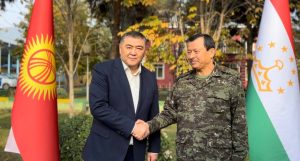Kyrgyzstan is considering changing its more than 30-year-old flag. “I support the idea,” said President Sadyr Japarov. “Our flag looks likes a sunflower; with this the country cannot rise from its knees.”
The Jogorku Kenesh, the country’s unicameral legislature, approved the first reading of the draft law last week to straighten the flag’s currently wavy rays. The cabinet of ministers has expressed its support for the initiative, which has drawn widespread discontent from Kyrgyz citizens.
While the flag issue has stirred domestic discontent and excited the global community of vexillologists, individuals who study flags, it overshadows developments on the contentious Kyrgyz-Tajik border.
On December 1, delegations from Kyrgyzstan and Tajikistan met in the city of Buston in Tajikistan’s Sughd Province as part of an ongoing effort to resolve border tensions between the two countries. Their roughly 975 kilometer border has never been fully delimited. Saimunin Yatimov, chairman of Tajikistan’s State Committee for National Security represented Dushanbe at the talks and announced that the negotiations were successful.
Although Yatimov did not provide full details at the time, he said that Kyrgyzstan will now have access to facilities it operates on Tajikistan’s territory, and the same will apply to facilities Tajikistan has on Kyrgyzstan’s territory. He noted that this allowing of access does not reflect a change in the ownership of any territory.
On December 5, the Kyrgyz government announced that “topographic working groups agreed on 24.01 km of the Kyrgyz-Tajik state border.”
These are significant breakthroughs for a conflict that had turned bloody just over a year ago.
Sporadic clashes occurred in the areas adjacent to the town of Batken between Kyrgyz and Tajik border troops throughout 2022. The conflict escalated in September 2022 when Tajik troops entered the demarcated territory of Kyrgyzstan, occupying a school in Dostuk village. There were also reports of shelling at the Batken Airport.
Kyrgyzstan declared a state of emergency in the Batken region, evacuating more than 136,000 civilians from the conflict zone. Kyrgyzstan reported 24 casualties while reportedly 30 Tajiks were killed as a result of the September escalations.
Japarov met with his Tajik counterpart, President Emomali Rahmon, on the sidelines of the Shanghai Cooperation Organization (SCO) summit in Samarkand that same month, where the two leaders reaffirmed a ceasefire.
Both Kyrgyzstan and Tajikistan host Russian military bases and are members of the Russian-led Collective Security Treaty Organization (CSTO). With the war in Ukraine sapping Russian military and political resources, Moscow is limited in projecting its security influence on Central Asia.
China has been increasing its defense cooperation with Tajikistan, especially in strengthening the Afghanistan-Tajikistan border since the Taliban’s return to power in August 2021. Both Kyrgyzstan and Tajikistan are heavily reliant on Chinese infrastructure investments. Sixty percent and 42.9 percent of Tajikistan and Kyrgyzstan’s total external debt, respectively, is owed to the state-run Export Import Bank of China.
Conflict stabilization remains a priority for both Kyrgyzstan and Tajikistan. With Moscow’s ability to act as a security guarantor in Central Asia increasingly constrained, the region’s governments have to decide either to manage conflicts internally or invite other external actors to assist them. Tajikistan already ceded 386 square miles of its Pamir mountain range to China in 2011, ostensibly ratifying a 1999 deal, but the move was observed as a way to finance Dushanbe’s growing debt to China.
The Kyrgyz government seems eager to change its flag to better reflect a country “rising from its knees,” but flags are inseparable from the land upon which they wave – the core issue between Tajikistan and Kyrgyzstan remains unresolved and could still flare up if negotiations fall through. If conflict does arise, which flag will Kyrgyzstan’s citizens rally around? Hopefully they will not have to decide.
Speaking on the main issue of the border, the chairman of Kyrgyzstan’s Committee for National Security, Kamchybek Tashiev, said, “The next meeting will be held in Batken, and a decision will be made.”

































